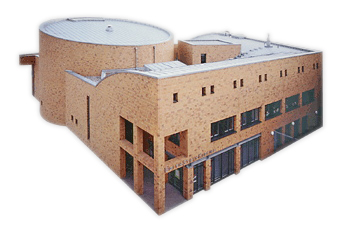Projects

At first glance, the catholic Edith-Stein Church lying between the administration and apartement buildings of Hamburg's Neu-Allermöhe quarter, is barely noticeable. Only the ocher-yellowed bricked walls differentiates it from the continuous red brick facade. The walls of the church give an almost windowless impression. "Altogether, the district has a distanced self-contained rather than appealing effect. Presumeably it is an appropriate possibility and the unspoken desire of the minority parrish not to appear too self-confident and flamboyant" (Martin Wurzer-Berger in Das Münster, January 1995)

The interior is arranged with warm, bright colors and their transparent simplicity is a clear contrast to the church's appearance from the outside.
The entire interior design, including the windows, the altar, and the organ were designed by the painter and sculptor W. Gies from Cologne.
The artist Gies, who "normally paints pictures who nobody has ordered", accepted the commission under the conditions that he has for the most part the freedom to plan as he desires. Several different organ builders submitted designs for the interior, with it's clear abstract symbols and use of carefully selected materials.
For Gies, these were all too conventional: "They were the usual styles, somewhere between neogothic and modern refrigerator."
 For the painter and sculptor W. Gies
it was the first and only organ that he ever designed. The organ builder
Michael Becker stood before a new and unusual challenge: the construction
oft an organ designed by n artist. The instrument that
W. Gies and Michael Becker brought to reality required a bit of
pioneer work.
For the painter and sculptor W. Gies
it was the first and only organ that he ever designed. The organ builder
Michael Becker stood before a new and unusual challenge: the construction
oft an organ designed by n artist. The instrument that
W. Gies and Michael Becker brought to reality required a bit of
pioneer work.
The new Becker organ is a complete mechanical slider chest organ with 16 registers, two keyboards, and a pedal. It was built within 6 months by Michael Becker and six apprentices. The maplewood cabinet encloses 1043 pipes, protects them from dust, mixes the sound, and sends it compactly into the room. The organ is 5.60 meters high, 4 meters wide, and 2,40 meters deep. The longest pipe ist 3.30 meters long. You can find more details of the instrument under the heading of List of Works.
Opinions
"What does the congregation think about find the modern form? Much better than expected. The older members are more openminded to it than the younger ones. The foreigners also show a great openmindness. The people like to go together to the service at the Edith-Stein Church. The impressive, cheerful room has a great effect. The window makes an immediate impression. The colourful doors do as well. Some people are fascinated by the processional cross. The Easter lights impress as well as the well proportioned altar. Not too few notice that everything has a noble form and organization. Some people even notice for themselves the basic intention of the form." (Text: Armin Mack, Pastor in the Edith-Stein Church until 1998)
